Will Smith Men In Black 3
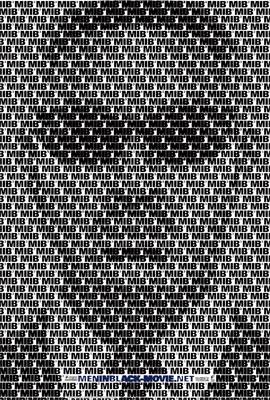
Men In Black 3 Review
Cast: Will Smith, Tommy Lee Jones, Josh Brolin, Emma Thompson, Alice Eve, Jemaine Clement, Nicole ScherzingerDirector: Barry Sonnenfeld
Genre: Action-Comedy
Rated: M
Running Time: 106 minutes
Synopsis: In Men in Black™ 3, Agents J (Will Smith) and K (Tommy Lee Jones) are back... in time. J has seen some inexplicable things in his 15 years with the Men in Black, but nothing, not even aliens, perplexes him as much as his wry, reticent partner. But when K's life and the fate of the planet are put at stake, Agent J will have to travel back in time to put things right. J discovers that there are secrets to the universe that K never told him -- secrets that will reveal themselves as he teams up with the young Agent K (Josh Brolin) to save his partner, the agency, and the future of humankind.
www.femail.com.au/men-in-black-3-review.htm
Release Date: May 24th, 2012
Website: www.MenInBlack3.com.au
About the Film
"The Men in Black movies are about the relationship between J and K," says Will Smith, who returns to one of his signature and favorite roles, Agent J, in Columbia Pictures' Men in Black 3. "This movie brings that home - it's about the power and origin of their relationship. It's actually an idea we've had for years - we had the concept before the second movie - but it needed time to mature. What we had to do was elevate the story, and the only way to do that is to go deeper, deeper into the characters, deeper into the revelations that the movie would reveal.""The relationship between J and K has been both contentious and affectionate at the same time throughout the movies," says Tommy Lee Jones, who again dons the suit and shades to play Agent K.
It has been ten years since the Men in Black were last seen protecting the Earth from the scum of the universe, and since then, there has been rampant speculation about a third film - but Will Smith says that it was always a given that there would be a third film. "We came to a point where we all felt that we had a fresh and compelling story that took the audience to a time and place they had not seen in this franchise," says Will Smith.
For his part, Will Smith was excited to put the black suit and shades on again. Agent J is one of his favorite characters and as he made his long-awaited return to the role there was nothing quite like getting into costume. "You can't beat the black suit," he says. "It's such powerful, iconic imagery. You put on the suit and the shades and it throws you into the mental space of the Men in Black. It's like a childhood fantasy - you know things that the other people don't know and you've got the most important job in the world. The seven-year-old boy in me comes running out when I put the black suit on."
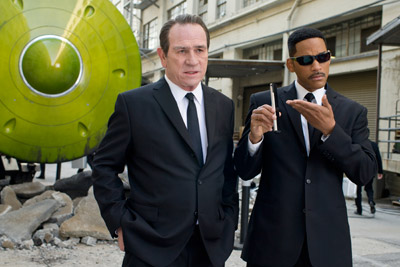 Tommy Lee Jones was similarly enthusiastic about playing the gruff Agent K. He says, "Any time you go to work with Will Smith is going to be a happy day, and Will Smith and Barry Sonnenfeld together make it an even happier day. They are wonderful people to work with."
Tommy Lee Jones was similarly enthusiastic about playing the gruff Agent K. He says, "Any time you go to work with Will Smith is going to be a happy day, and Will Smith and Barry Sonnenfeld together make it an even happier day. They are wonderful people to work with." The story of Men In Black 3 takes the filmmakers back - back to the characters' origins, back to the key moments of their relationship, to focus on the key elements that have kept them at arms' length from each other for 15 years - and looked for ways to resolve the conflict. The answer came in sending Agent J back - back in time.
"We wanted the movie to be both familiar and different," says Barry Sonnenfeld, who has taken the helm of all three Men In Black films. "What's familiar is the characters and premise of the Men in Black and who they are. We wanted to bring Will Smith and Tommy Lee Jones back together again. But we also wanted something new and inventive, and that came in the time travel element."
"At the beginning of the movie, J and K are still partners - but they haven't learned much about each other in all their time together," says producer Walter F. Parkes. "In fact, at the very beginning of the story, the character of Zed has recently died and K gives a eulogy that provides no information whatsoever about him. This despite the fact that Zed was supposedly his best friend for 45 years. It makes J think, after all these years, what do I really know about the guy sitting next to me? That is the foundation for our story, and it coincides with the escape of an alien, Boris the Animal, that K put away 40 years earlier, in 1969 - and he's coming back for some kind of payback on K."
Some kind of payback, indeed: Boris jumps back in time to 1969 and kills K. No one in 2012 has any memory that K wasn't murdered 40 years earlier - no one except J, who is wondering what happened to his partner. To save K, J follows Boris back into the past - and as he does, he sees an opportunity to learn more about his partner. "J sees saving K as a great opportunity to learn secrets about K - he thinks he'll find out why K is so grumpy and reserved," says Barry Sonnenfeld. "But as it turns out, the young Agent K is open, friendly, and interested."
In 1969, Agent K is played by Josh Brolin, who gives a sly, smart performance as Young K that channels Jones' mannerisms and characterisations while also making the character his own.
"We shot the acts sequentially - we had Tommy Lee Jones playing K in the first act, then Josh Brolin came in playing K for the second act and almost all of the third act, and then in the last week of shooting we got Tommy back," says Barry Sonnenfeld. "What I found amazing was that I kept thinking I was directing one actor; the performances were so consistent that it was hard for me to tell where Tommy Lee Jones ended and Josh Brolin began. For me, it's not about Tommy Lee Jones playing K or Josh playing K. It's just K."
"I've seen the first film 45 or 50 times - I'm not exaggerating," says Josh Brolin. "I'm a huge fan of the chemistry between Tommy Lee Jones and Will Smith. Tommy Lee Jones' voice has a cadence to it that's very specific to Men In Black - it's very different from the way he speaks in life. I just listened to it and listened to it and listened to it until I started dreaming about it. I don't know if I got it, but my friends would tell me that I sounded like him. I'd go out to dinner, and I'd hear, 'You're ordering like Tommy Lee Jones.'"
Of course, even as the movie explores the characters' relationships, it isn't a heavy drama. It's Men In Black, and that meant it would deliver trippy Rick Baker aliens, cool gadgets, and big laughs. All of that adds up to an irresistible tone that isn't quite like any other film. Barry Sonnenfeld says that the key to the tone - the only way to make the movie really funny - is for everyone to play it entirely straight. "I want the situations to be funny, but the performances to be real, so I don't want the actors trying to be funny," he explains. "I don't want the composer to think 'comedy,' because then the music will be comedy music. I don't even want the cinematographer or the lab that develops the film to think it's a comedy, because the next thing I know, it'll look too bright. If I can surround the absurd situation with something real, it'll be a great comedy."
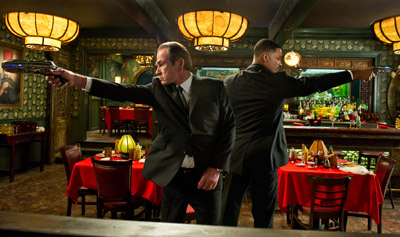 The team behind the scenes includes seven-time Oscar®-winner (including one for his work on Men In Black) Rick Baker designing the aliens; five-time Oscar®-winner Ken Ralston and Jay Redd supervising the visual effects; Director of Photography Bill Pope, who shot the Matrix movies and Spider-Man™ 2 and 3; production designer Bo Welch, who creates not only the futuristic world of the Men in Black in 2012 but also the retro-futuristic world of 1969; Editor Don Zimmerman; music by Danny Elfman, the film's composer; and costume designer Mary Vogt, who dressed Messrs. Will Smith and Tommy Lee Jones in their iconic black suits the first two times around as well.
The team behind the scenes includes seven-time Oscar®-winner (including one for his work on Men In Black) Rick Baker designing the aliens; five-time Oscar®-winner Ken Ralston and Jay Redd supervising the visual effects; Director of Photography Bill Pope, who shot the Matrix movies and Spider-Man™ 2 and 3; production designer Bo Welch, who creates not only the futuristic world of the Men in Black in 2012 but also the retro-futuristic world of 1969; Editor Don Zimmerman; music by Danny Elfman, the film's composer; and costume designer Mary Vogt, who dressed Messrs. Will Smith and Tommy Lee Jones in their iconic black suits the first two times around as well. According to Walter F. Parkes, it was Rick Baker's idea to have a little fun in his alien designs. "He came in one day and said, 'What if the aliens in 1969 were 1960s aliens, retro-futuristic aliens that reflected our collective memory of that time and a more innocent approach to sci-fi?' It was just such a charming idea, and everyone went for it."
"The aliens capture a texture, a wonderful sense of humor, and a clever inventiveness that lends itself to this world," says Will Smith.
The demands of the film required close coordination between Rick Baker and Ken Ralston - each legends in their respective fields of make-up and visual effects who have known each other since their teenage years. "I was excited to be working with Ken Ralston," says Rick Baker. "I thought, 'Now we can really do a nice marriage of our techniques.'" Knowing each other as well as they do, Rick Baker and Ken Ralston could work out whether make-up, animatronics, or CG provided the best solution to each design challenge on a case-by-case basis.
Bringing it all together is director Barry Sonnenfeld. Josh Brolin says, "You couldn't have Men In Black without Barry Sonnenfeld. He brings a style and energy to what he does that makes this franchise what it is. You couldn't ask for a more perfect choice to direct these movies. You watch him as he's directing a scene and he is so into it, viscerally into it."
"Barry Sonnenfeld has a very, very good visual sense - I think because he used to be a DP," says Rick Baker. "But maybe his greatest skill as a director is to be open to the ideas of the people around him. He hires people that he believes in and knows are good, talented people - and he genuinely wants their opinions about the work they are doing."
Mr. Smith and Mr. Jones, Meet Mr. Brolin
When Agent J jumps back in time to 1969, he almost immediately comes into contact with the man who will become his partner in 25 or 30 years - Agent K. The filmmakers turned to Josh Brolin to build on Tommy Lee Jones' performance as the older K to interpret and channel the character as a young man.
"You'll hear all the time a producer say, 'Well, if we didn't find this particular actor, we could never have cast the role' - but that was never more true than with Josh Brolin playing this part," says producer Walter F. Parkes. "You can find a picture of Tommy Lee Jones as a lineman for Harvard and compare to a picture of Josh Brolin in Milk, with his hair cut in an early-1970s style. It's amazing - they're dead ringers for each other. But it's not just about how he looks. He had to deliver Tommy Lee Jones, but he couldn't do an impersonation - he had to do an interpretation. I think his performance is one of the delights of the movie."
"Will Smith and Tommy Lee Jones are an iconic duo," says Josh Brolin. "It wouldn't work if another actor came in as a third wheel. But when they explained to me the plot of the film and my role - that J goes back in time to 1969 and I would play the young K - well, I'm in. I'm in without even thinking about it, because there's a character I want to play."
"Being a part of this movie is crazy for me," Josh Brolin continues. "When you go see a great movie, like Men In Black, you're in the audience thinking, 'Wow, I want to be those guys.' You want to be that cool, to have that chemistry with someone. And then you're asked to do it - it's like winning the lottery. When I put on the suit, it was the most surreal feeling in the world - I felt like Superman."
In approaching his role, Josh Brolin says he relied on a careful mix of actors' tools. "I started with a caricature and whittled away from there," Josh Brolin explains. "But we really created our own thing. It was less about 'How am I going to do Tommy Lee Jones?' than finding a rendition of Tommy Lee Jones and then making it our own."
"There's a certain rapport or repartee that you'll develop with an actor, and that becomes your timing, how you create," Will Smith says. "Josh Brolin had studied Tommy Lee Jones so well that there wasn't a single missed beat when Josh Brolin came in. It was almost the identical chemistry, which is very difficult to come by."
Animal Instincts
In casting the role of the bad guy - and Boris the Animal is a very bad guy - the filmmakers took flight and cast Jemaine Clement, best known for his role as half of the HBO duo "Flight of the Conchords." Walter F. Parkes, who had previously worked with Clement on the comedy Dinner for Schmucks, says that Jemaine Clement has the imposing physicality and nuanced delivery that the part requires. "What surprises me most about his performance in this movie is that he's scary, he's erudite, he's mean, he's funny, he's charming - all rolled into one performance as Boris," says Barry Sonnenfeld.
How did he do it? Well, Barry Sonnenfeld says, there's evidence that Jemaine Clement is not of this Earth. "Jemaine Clement must be an alien, because no one could go through the four hours of makeup he endured every morning and still be in a lovely mood like he was," says the director.
What was it like to play Boris the Animal? "It's just Boris," says Jemaine Clement, channeling his character. "It really grates him to be called 'The Animal.'"
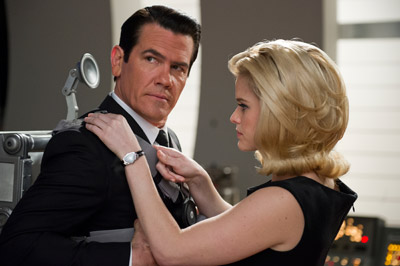 To play the role, Jemaine Clement adopts a stilted English (inspired by English learning tapes) and a scene-stealing laugh. "His laugh is described in the script as a horrible, guttural sound, so I just tried to do it as it was written," he says. "One of the first humans he meets when he gets to Earth laughs at him. It's a sound he's never heard before - Boglodites don't laugh, I guess - so to fit in amongst humans, he adopts it, but gets it quite wrong."
To play the role, Jemaine Clement adopts a stilted English (inspired by English learning tapes) and a scene-stealing laugh. "His laugh is described in the script as a horrible, guttural sound, so I just tried to do it as it was written," he says. "One of the first humans he meets when he gets to Earth laughs at him. It's a sound he's never heard before - Boglodites don't laugh, I guess - so to fit in amongst humans, he adopts it, but gets it quite wrong." At one point in the film, the Boris of 2012 meets the Boris of 1969. "It's tricky," says Jemaine Clement. "It can be hard enough to remember one set of lines. Playing opposite myself, not only do you have to remember both sets of lines, but the scene is fairly fast-paced - on the second time around, I had to get the line in before the recording of myself says the next line. And I had to react to myself the whole time."
Michael Stuhlbarg turns in his own scene-stealing performance as Griffin, a nervous alien with a soft spot for the underdogs of human history. He's a guy who sees the downside, upside, and middleside of every situation as he lives in a realm of multiple possible realities and trying to figure out which of the many possibilities he is currently experiencing. "He disappears, kind of like the White Rabbit, with J and K chasing after him," says Michael Stuhlbarg. "It's through the things that Griffin tells them that they learn where to find him next. So he's always ahead of them, which is kind of wonderful to play."
Griffin speaks quickly - maybe too quickly for J and K to catch everything. "Barry Sonnenfeld was very specific about what he wanted," Michael Stuhlbarg explains. "Griffin is curious and anxious about the situation he finds himself in. He speaks as fast as he possibly can because he's living through all of these different realities, and he's always trying to remember how it played out so it won't happen again."
Emma Thompson rounds out the lead cast as O, the new head of the MIB, taking over for the recently departed Zed. "Just about the only aspect of Zed's leadership that she's inherited is his irritability," she jokes.
"I think it's impressive that a woman can be the head of this powerful organisation, although it does call the name of that organisation into question," she says. Still, she admits, "I don't think 'People in Black' works quite so well."
Emma Thompson says that finding the right tone to her performance was demanding and tricky. "It has to be absolutely serious but also very funny, or sometimes very emotional then switching immediately," she notes. "Luckily, all of my training is in comedy, so it was great fun for me, even if technically, it was very demanding."
The cast is also peppered with impressive cameo performances, including Bill Hader, who turns in a memorable scene as Andy Warhol when J and K crash The Factory in 1969. He recalls, "We were filming a scene, Barry Sonnenfeld called 'Cut,' and I couldn't help it - I turned to Will Smith and said, 'Dude, I'm in a Men In Black movie!'" he says, laughing. "Will Smith said, 'I know!'"
Alice Eve also joins the cast as the young O, who in 1969 is a young colleague of the Men in Black but is destined for a greater role. In addition, onetime Pussycat Doll Nicole Scherzinger opens the movie in flamboyant fashion as she brings a special gift to Boris in prison.
About the Production
Four-time Oscar® nominee Bo Welch, who designed the previous two Men In Black films, returns for thirds. "The film is set in New York, which has always considered itself the center of the universe as we know it," he says with a wink. "The irony is that it turns out New York is the center of a larger universe where aliens come and go, migrating across several galaxies."
And why not? "New York has a vibe to it that I think would allow aliens to feel right at home," says Sonnenfeld. "To this day, when I walk through Times Square and I see some of the people, I go, 'Mmmm…. Not human. That's an alien.'"
The MIB films are always a challenge for production design, pushing the boundaries of reality while staying within the realm of the possible, but Bo Welch would have an additional challenge this time around as he would have to design two worlds - one taking place in 2012 and another in 1969.
As the conceit is that the MIB have remained in the same space for over 40 years - with that space updated with the times - Bo Welch created the 2012 MIB headquarters set for the scenes in the first act, then, during the film's holiday hiatus, re-dressed the entire set for 1969. "We changed basically every square inch," he says.
Upon their return for the first day of filming, the actors were in for a pleasant surprise. "I walked into the 1969 headquarters and it was like magic," says Will Smith. "Bo Welch has been able to create and re-create that quintessential Men In Black look - I'm happy to be on his team."
Among the additions to the 1969 HQ are a couple of vast rooms containing an acre of Univac computers and the MIB neuralyzer.
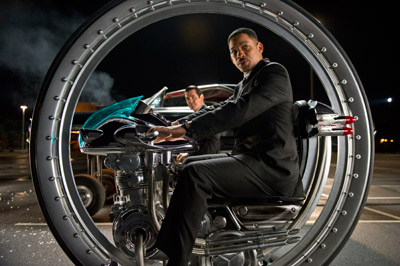 In keeping with the rest of the tone of the film, Bo Welch says he never went for an obvious laugh. "I'm not designing things to be humorous. They just happen to be funny," he says. "I tried to put myself in 1969 and ask myself, 'What would it really be like?' If you stay too far ahead, you haven't capitalised on the joy and fun of time travel. I take my cues from the material and, in this case, 1969 gives you a huge, deep vast mine of inspiration to generate the props, the sets, the weapons, the vehicles."
In keeping with the rest of the tone of the film, Bo Welch says he never went for an obvious laugh. "I'm not designing things to be humorous. They just happen to be funny," he says. "I tried to put myself in 1969 and ask myself, 'What would it really be like?' If you stay too far ahead, you haven't capitalised on the joy and fun of time travel. I take my cues from the material and, in this case, 1969 gives you a huge, deep vast mine of inspiration to generate the props, the sets, the weapons, the vehicles." A major set piece for Bo Welch that required close interaction with VFX supervisor Ken Ralston is the Apollo 11 moon launch of July 16, 1969. "I see a lot of movies where the explosions and effect all feel very digital, sort of like a video game," says Barry Sonnenfeld. "For me, the best effects are the ones that you don't even know that they are effects. That's what Ken Ralston is so good at - his effects are all about reality. He watches the way I direct the scenes and works with Bill Pope, the cinematographer, and Bo Welch, and we all work together, as a team, with a singular, unified viewpoint."
Bo Welch and property master Doug Harlocker also did their research into Andy Warhol's Factory. "One thing Bo Welch found was that Andy Warhol put up aluminum foil in his place, so we did that, too," says Doug Harlocker. The propmaster also created pieces that reflected the high pop art aesthetic of the period. "They had interesting buffets that were more art than food, so we sculpted a large boar and put it on a bed of apples, as though it was bleeding fruit," he says.
Re-creating New York in 1969 also required Bo Welch's and Ken Ralston's expertise. "New York has changed so much in the last 40 years," says Bo Welch. "We picked our locations carefully, and then augmented with dressing and signs."
The filmmakers were also responsible for rebuilding Shea Stadium and presenting it in its glory days of 1969, and Harlocker was responsible for helping to give the stadium its authenticity: "Banners or pins from Shea Stadium, period Cracker Jack boxes, the proper kind of paper cup that beer was dispensed in - all of that we either had to generate or find through collectors."
About the Aliens
Rick Baker's inventive (and Oscar®-winning) aliens are a vital part of Men In Black, so it's no surprise that the legendary artist returns for Men In Black 3. For Rick Baker, working on the Men In Black movies is especially fulfilling because the films inevitably require him to design in so many different ways: "Some films are straight makeup - say, we'll do age makeup. Others will call for fake bodies or heads. Others, we'll make animatronic characters and puppets. The Men In Black movies involve all of those things - and I got to design for the computer-generated stuff as well. We ended up making about a hundred aliens for this movie, and you could have made a whole story about any one of them."
Barry Sonnenfeld says that Rick Baker's sensibilities mesh perfectly with the "play it straight" tone he brings to the rest of the movie. "You don't want to design weird, wacky aliens," he says. "If the aliens are funny, you want it to come out of observational humor, or their attitude, or the audience thinking, 'Oh, that's interesting.'"
Production designer Bo Welch says that before finalising his set designs, he first looks to Rick Baker's creations to make sure everything will mesh. "He designs fabulous aliens and I design an environment that highlights them," he says. "We use a very tightly controlled palette, so the textures, shapes, and colors of the aliens can breathe and be seen and enjoyed in their full glory and splendor."
For the 1969 sequence, Rick Baker came up with the idea that the aliens would be "retro" - that is, inspired by the aliens seen in 60s-era sci-fi. "The challenge on the first Men In Black movie, and it's stayed our challenge since then, is to do aliens that look unlike any aliens that we've seen before," says Rick Baker. This time around, Rick Baker pitched the filmmakers on a unique solution: "Let's intentionally do aliens that look like something we've seen before, only a better version of them. Let's imagine that the guys who made monster movies back in the 50s and 60s really happened to see a real alien and based their monster design on that. And they liked that idea. That was where I really had fun on this movie - to do my version of those classic science fiction aliens as a lot of fun."
How does one design a retro alien? "Lots of brains and veins, stuff like that," he says. "We have an alien based on a fish, definitely from an aquatic world. I have a cameo in the film, where I'm an alien with an exposed brain. By comparison, our 2012 aliens are much more sleek and polished."
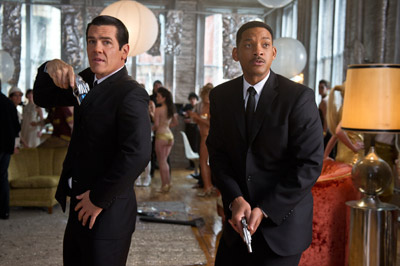 Of course, Rick Baker also designed the lead alien: the bad guy, Boris the Animal, played by Jemaine Clement. Rick Baker designed a very badass biker costume, complete with goggles that seem to be embedded deep in Boris's eye sockets. "I got the chance to make Jemaine Clement into something he really isn't," says Rick Baker. "He's really a very gentle man, but in the costume, he is much more menacing - and, the women on set have told me, sexy."
Of course, Rick Baker also designed the lead alien: the bad guy, Boris the Animal, played by Jemaine Clement. Rick Baker designed a very badass biker costume, complete with goggles that seem to be embedded deep in Boris's eye sockets. "I got the chance to make Jemaine Clement into something he really isn't," says Rick Baker. "He's really a very gentle man, but in the costume, he is much more menacing - and, the women on set have told me, sexy." "When I first came in, Rick Baker sat me down and asked, 'Are you claustrophobic?'" Jemaine Clement recalls, laughing. "He asked me all of these questions - I'm not sure if they were intended to scare me, and they did scare me a little. He also mentioned that a lot of people who do a makeup-effects character only do it once in their careers." And with good reason: on his first day on set, Jemaine Clement spent eight hours in the makeup chair (a total that was soon streamlined to three-to-four hours once they established a rhythm).
Of course, it's not all aliens and monsters. Make-up artist Christian Tinsley was tasked with making Josh Brolin look just a little more like Tommy Lee Jones: the actor was fitted with a mold of Tommy Lee Jones's nose that was found in the studio archives from 20 years ago.
In addition, Rick Baker transformed Bill Hader into Andy Warhol. "I really enjoyed the couple of days I spent with Bill Hader, doing his makeup, because we love the same kinds of movies. We had a lot of fun talking while we were doing the makeup," says Rick Baker. "And, it turns out, he's a fan of my work, so he knew what to expect - he was good in the chair."
In the end, it seems that when Rick Baker is working on the Men In Black films, he's like a kid with his hands on a really great practical joke. "Emma Thompson said to me that one of the things she liked about the first two Men In Black films was that the aliens aren't necessarily in your face all the time, but they're there. You know, an alien might appear for only a few frames past somebody in the Men in Black headquarters, but it's fun to do that. I think it's cool to put in aliens that people won't even see until their fourth or fifth time around. For example, in this movie, in the Coney Island sequence, there's a crazy alien in the back playing pinball. You have to look for it."
The Vehicles and Weapons
"The Men In Black cars have always been cool," says Barry Sonnenfeld, meaning they would have to find a car suited to the MIB from 1969. Their answer: the Ford Galaxy. "Not only does it have an iconographic look, but anything called the Galaxy seems like it belongs in our movie," Barry Sonnenfeld explains.
Bo Welch says that the car stands out for its oversized beauty. "We went with the two-door version, which I think is so much better looking than the four-door. It's got a great tail - everything about it evokes space travel to me."
Of course, that's not J and K's only way of getting around 1969 New York: they also have monocycles, single-wheeled vehicles with a gyroscopic center seat.
The monocycle is the only way to keep up with Boris, who has his own menacing ride. "We wanted a bike that blends in with 1969 biker culture, but also fit Boris's design, meaning it should incorporate organic and hardware in beautiful harmony," says Bo Welch.
The 9½-foot-long bike weighed 800 pounds and reached 100 mph. "It's half-creature, half-jet engine," says Doug Harlocker. "It's an amalgamation of all sorts of technologies."
Another integral element to the MIB universe are the myriad gadgets and weapons used by the agents - only now, we get to see some of the earlier, prototype versions during the 1969 scenes.
For example, the memory-erasing neuralyser is, by 2012, sleek. By contrast, in 1969, the neuralyser takes up an entire room at headquarters. "In 1969, it's the same shape, but a hundred times larger and powered by tubes," says Bo Welch. "As our technology always does, it got smaller and cleaner by 2012. Back in 1969 it was still large and clunky - and yet gorgeous."
"The inspiration was MRIs," says Bo Welch. "You get loaded into the machine and spit out the other side. It's loud and violent and horribly dangerous because it's new technology that hasn't been refined yet."
Doug Harlocker's team constructed a vessel weighing 6,000 pounds, 18 feet long and 14 feet high, in which only one person could be neuralysed at a time. "One of the things we tried to do with the 1969 scenes was make things big and cumbersome. I think that's funny," he says.
Perhaps the most lethal weapons in the movie belong to Boris. Jemaine Clement explains: "Inside Boris's hands lives his henchman, which we called his 'weasel.' It is a horrible, vicious creature that fires porcupine-like, deadly sharp quills, usually into people's foreheads." The weasel was a collaboration between Ralston and Baker, and the quills were carried out from Rick Baker's design and realised by Doug Harlocker's team, as they manufactured, painted, and added hair to 125 quills based on Rick Baker's design.
About the Costumes
You can't have the Men in Black without their iconic suits, so putting the men back in black was costume designer Mary Vogt.
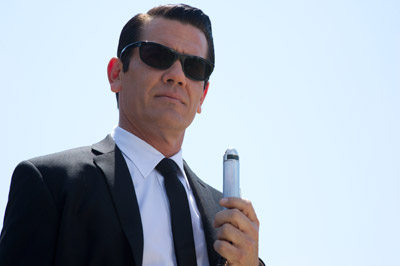 One might think that a black suit is a black suit, but costumes aren't fashion: each of the leads would require a number of suits, each designed to do a specific task. "Will Smith and Josh Brolin each have about 25 suits," says Mary Vogt. "They do different things - there are suits for harnesses, for stunts, for hero shots."
One might think that a black suit is a black suit, but costumes aren't fashion: each of the leads would require a number of suits, each designed to do a specific task. "Will Smith and Josh Brolin each have about 25 suits," says Mary Vogt. "They do different things - there are suits for harnesses, for stunts, for hero shots." If 25 suits for each of the leads sounds like a lot, get a load of Boris's threads count. "He has a different outfit for every different stunt," says Mary Vogt. In recalling the days of easy riders, Mary Vogt says, "we gave him a light-colored motorcycle jacket with fringe, bandana, and glasses - we wanted the audience to immediately be able to tell the difference between 2012 Boris and 1969 Boris," she explains.
Of course, it also fell to the costume designer to dress the women in the film. Mary Vogt had originally planned on dressing Emma Thompson's character, O, in a pantsuit, but after seeing the actress's impressive gams, she ended up putting her in a skirt-suit instead.
Likewise, when Nicole Scherzinger arrived to play Boris's paramour in the opening scene, the impulse to give her a "sexy librarian" look was scrapped in favor of a straightforward sexpot. "She's Nicole Scherzinger. She looks fantastic in a tiny, sexy black dress and boots. It's a no-brainer," says Mary Vogt. "She looked great in her quasi-Bettie Page hairdo, and she could walk in five-inch heels like they were bedroom slippers."
About the Visual Effects
Sony Pictures Imageworks' visual effects legend Ken Ralston, who has won five Oscars® for his work, takes on the Visual Effects Supervisor role with Jay Redd, whose previous experience includes serving as visual effects supervisor on Imageworks' CG-animated film Monster House.
Ken Ralston explains that though several sequences in the film represented exciting VFX challenges - from building a prison on the moon to re-creating the Apollo 11 launch - the biggest challenge of all was to achieve a look that meshed with the film Barry Sonnenfeld was directing. "Barry Sonnenfeld has a very distinct style," says Ken Ralston. "It's very graphic, very distinctive to his movies. Our designs had to be stylised, they had to live within his world, but at the same time, it had to feel believable - even when something unbelievable was happening."
"Barry Sonnenfeld's sensibility and his whimsical take on the material allowed us to play a little bit with what might be expected to be real," says Jay Redd.
A good example is the time jump. To go back to 1969, Agent J jumps off the 61st floor of the 77-storey Chrysler Building (don't try this at home, kids - Agent J is a professional). "Ken Ralston and I stood at the top of the Chrysler Building to take reference photos," says Jay Redd. Looking down the 61 stories from the landing to the street, they started to wonder how long it would take for Agent J to fall in real life? Turns out, just a few seconds. To extend Agent J's fall into a two-minute-plus sequence, not only would Ken Ralston and Jay Redd have to play with the physics, but also get across the idea that J is traveling through time. "It's a big challenge to show the audience what time travel looks like," says Jay Redd. "Dinosaurs sure mean prehistoric, but how do we show that we are in the Depression, in World War II? We looked for icons, and we started planning at where in the fall, where 'on the building' we would need to be in each section. I think our building is about 800 stories tall, but nobody's going to notice - it's our job as artists and filmmakers to create the illusion that what's happening could really happen in the real world."
Ken Ralston was one of the very first people to join Barry Sonnenfeld in working on the movie, and he ended up in a close collaboration with each of the department heads, from production design to wardrobe to mechanical effects, to help give each the benefit of visual effects when needed. For example, production designer Bo Welch designed the monocycles that J and K employ to chase Boris through Queens in 1969 - then passed the torch to Ken Ralston and Jay Redd's talented CG artists, who built the monocycles in the computer - some sequences entirely computer generated - and re-created New York in the 60s as the backdrop for the elaborate chase sequence.
But perhaps no collaboration was closer than with Rick Baker's makeup effects squad. "Rick Baker and I first met when we were 17, doing commercials - I've known him forever, but we've never worked together," says Ken Ralston. "It was so much fun to have him around and work with him."
The collaboration ranged from the simple to the extensive. "You never know which alien Barry Sonnenfeld is going to grab and put into a close-up," says Ken Ralston. "We could take some of Rick Baker's aliens and add some small things - say, some additional animation around the eyes, some blinks, antennae moving around, an extra limb." But Rick Baker and Ken Ralston also worked together to create Boris the Animal. "Rick Baker designed a very cool idea, where the head and a lot of the features look like closed fingers or claws," Ken Ralston explains. "When he comes unglued or gets really angry, the fingers all open up and you start to see some of the strangeness inside his head. Rick Baker created the creature, and we talked all the time about what we could do with him, because there would come a point where we would take over and augment his work."
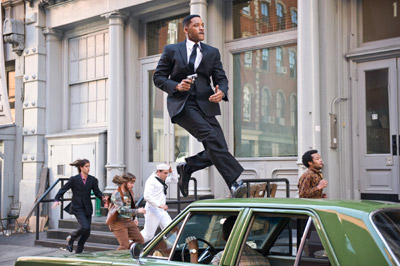 Ken Ralston and Jay Redd's teams also created several digital sets, from the prison on the moon that (it turns out) can't hold Boris to Shea Stadium in 1969 (which, it turned out, couldn't hold the Mets - the stadium was demolished in 2009 as the baseball team moved to Citi Field). "The prison break is a pretty great way to start the movie," says Ken Ralston.
Ken Ralston and Jay Redd's teams also created several digital sets, from the prison on the moon that (it turns out) can't hold Boris to Shea Stadium in 1969 (which, it turned out, couldn't hold the Mets - the stadium was demolished in 2009 as the baseball team moved to Citi Field). "The prison break is a pretty great way to start the movie," says Ken Ralston. The most elaborate digital set piece in the film comes at the climax, as J and Young K chase not one but two Borises through the gantry holding the rockets that would launch the Apollo 11 mission towards the moon. The trick to the sequence is producing a faithful digital re-creation of an iconic event that everyone has seen hundreds of times while also creating everything that the director needs to tell the story. "Reality is great, but sometimes, reality can be boring. The Men In Black movies are all about creating a heightened reality, a fantasy reality. We started with reality, then tried to go beyond but still have it feel like it's in the real world," says Jay Redd. "We had to have the iconic imagery from the Apollo 11 launch, but for dramatic or pacing purposes, we might have to change things - how many floors there are in the tower, how much smoke there is at a given time, how far the beach is from the rocket.
"We try to make you believe that two agents and two Borises are running around fighting each other," Ken Ralston says. "We have all the smoke blowing around, the steam, the vents, the really cool angles of the rocket. The lighting has to have a certain quality. It's all stylised to feel like it's part of the movie, but it also feels like they're really there."
Jay Redd adds that the way the director - an accomplished director of photography in his own right before transitioning to directing - helped give the sequence a unique Men In Black feel. "Barry Sonnenfeld's shooting style - wide angle lenses and lots of light - adds a sense of comedy while still retaining a sense of tension and pace," he says.
MORE
- Emma Stone Magic in the Moonlight
- Jessica De Gouw Cut Snake
- Maxine Peake Funny Cow
- Denzel The Equalizer 2
- Johnny Flynn Beast
- Logan Marshall Green Upgrade
- Shailene Woodley Adrift
- Eric Toledano and Olivier Nakache C'est La Vie...
- André Leon Talley The Gospel According To André...
- Shakespeare In Tokyo
- Mission: Impossible Fallout
- Glenn Close The Wife
- Allison Chhorn Stanley's Mouth Interview
- Benicio Del Toro Sicario: Day of the Soldado
- Dame Judi Dench Tea With The Dames
- Sandra Bullock Ocean's 8
- Chris Pratt Jurassic World: Fallen Kingdom
- Claudia Sangiorgi Dalimore and Michelle Grace...
- Rachel McAdams Disobedience Interview
- Sebastián Lelio and Alessandro Nivola...
- Perri Cummings Trench Interview



